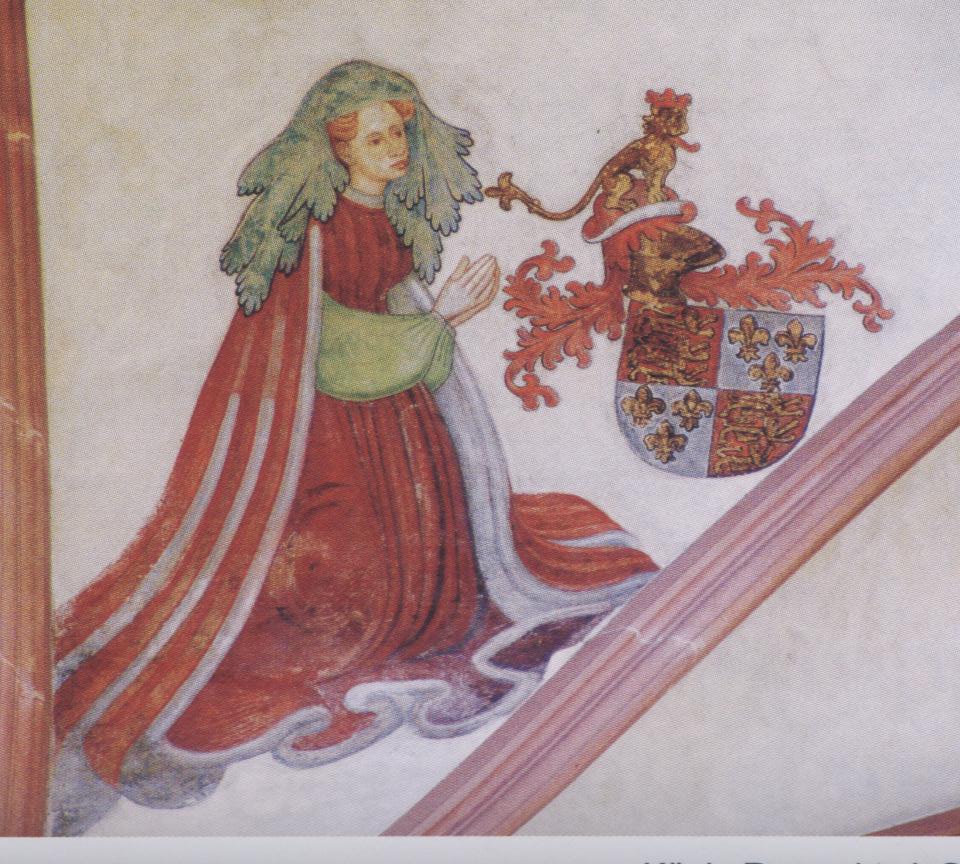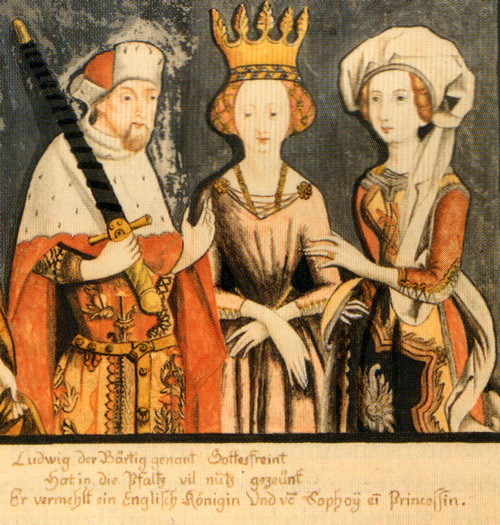by Susan Flantzer
© Unofficial Royalty 2023

Painting of Blanche in the chancel of the Church of St. Aegidius in Neustadt, Germany where she is buried; Credit – Wikipedia
Blanche of England was born in the spring of 1392 at Peterborough Castle in Peterborough, England. She was the fifth of the six children and the elder of the two daughters of King Henry IV of England and his first wife the wealthy heiress Mary de Bohun, Countess of Northampton, Countess of Derby. Blanche’s paternal grandparents were John of Gaunt, 1st Duke of Lancaster, (the third surviving son of King Edward III of England) and Blanche of Lancaster, Duchess of Lancaster, her namesake and the heiress of England’s wealthiest and most powerful peer, Henry of Grosmont, 1st Duke of Lancaster. It was through Blanche of Lancaster that the Duchy of Lancaster came into the royal family. Since the reign of King Henry IV, the Duchy of Lancaster has provided a source of independent income to the British sovereign. Blanche’s maternal grandparents were Humphrey de Bohun, 7th Earl of Hereford, and Joan FitzAlan, daughter of Richard FitzAlan, 10th Earl of Arundel and 8th Earl of Surrey. When Blanche was two years old, her mother died while giving birth to her last child Philippa.
Blanche had five siblings:
- King Henry V of England (1386–1422), married Catherine of Valois, had one son King Henry VI of England
- Thomas of Lancaster, 1st Duke of Clarence (1387–1421), married Margaret Holland, no children
- John of Lancaster, 1st Duke of Bedford (1389–1435), married (1) Anne of Burgundy, no children (2) Jacquetta of Luxembourg, no children
- Humphrey, Duke of Gloucester (1390–1447), married (1) Jacqueline, Countess of Hainaut and Holland, no children (2) Eleanor Cobham, no children
- Philippa of England (1394–1430) married Eric of Pomerania, King of Denmark, Norway and Sweden, no children
In 1398, Blanche’s father, then known as Henry of Bolingbroke because he was born at Bolingbroke Castle in Lincolnshire, England, quarreled with Thomas de Mowbray, 1st Duke of Norfolk, who accused him of treason. The two men planned to duel, but instead, Henry’s first cousin King Richard II banished them from England. John of Gaunt died on February 3, 1399, and Richard II confiscated the estates of his uncle and stipulated that his cousin Henry would have to ask him to restore the estates. Henry returned to England while his cousin Richard II was on a military campaign in Ireland and began a military campaign of his own, confiscating the land of those who had opposed him. King Richard II eventually was abandoned by his supporters and was forced by Parliament on September 29, 1399, to abdicate the crown to his cousin Henry. King Henry IV was crowned in Westminster Abbey on October 13, 1399. Richard was imprisoned at Pontefract Castle in Yorkshire where he died on or around February 14, 1400. The exact cause of his death, thought to have been starvation, is unknown.
In 1403, Blanche’s father King Henry IV married again to Joan of Navarre, the widow of Jean IV, Duke of Brittany, and the daughter of Charles II, King of Navarre and Jeanne of Valois. Henry IV and Joan had no children but Joan got along well with her stepchildren.
After King Henry IV deposed his first cousin King Richard II, it was important for him to legitimize his rule. Ruprecht III, Elector Palatine and King of the Romans was a needed ally. A marriage between Ruprecht’s eldest surviving son and heir Ludwig, Count Palatine, the future Ludwig III, Elector Palatine, and Henry IV’s eldest daughter Blanche was arranged. The marriage contract was signed on March 7, 1401. Ten-year-old Blanche married twenty-four-year of Ludwig on July 6, 1402, at Cologne Cathedral in the Free Imperial City of Cologne, now in Germany.

The Crown of Princess Blanche; Credit – By Allie Caulfield – This file has been extracted from another file, CC BY 2.0, https://commons.wikimedia.org/w/index.php?curid=65073992
Blanche’s dowry included a crown thought to have originally belonged to Anne of Bohemia, the first wife of King Richard II of England, whom she married in 1382. Known as the Crown of Princess Blanche, the Palatine Crown, and the Bohemian Crown, Blanche wore it at her wedding. Made of gold with diamonds, rubies, emeralds, sapphires, enamel, and pearls, the crown has been the property of the House of Wittelsbach since 1402, and is displayed in the treasury of the Munich Residenz, where it has been kept since 1782. This writer has been fortunate to have seen the crown and can verify that it is spectacular.
Blanche and Ludwig had one child:
- Ruprecht, Count Palatine (1406 – 1426), unmarried, nicknamed Ruprecht the Englishman

Ludwig III, Elector Palatine with his two wives: his first wife Blanche of England in the middle and his second wife Matilda of Savoy on the right; Credit – Wikipedia
On May 22, 1409, Blanche, aged seventeen, died while pregnant with her second child, possibly from the plague, at Neustadt, Electorate of the Palatinate, now in Rhineland-Palatinate, Germany. She was buried in the Church of St. Aegidius (link in German) in Neustadt.

Blanche’s tomb at the Church of St. Aegidius in Neustadt.; Credit – Wikipedia
A year after her death, Blanche’s widower succeeded his father as Ludwig III, Elector Palatine. In 1417, Ludwig married Matilda of Savoy, and the couple had five children. However, Ruprecht, Ludwig’s son from his first marriage, remained the heir presumptive to the Electorate of Palatinate and Ludwig allowed Ruprecht to participate in the affairs of state.
On May 20, 1426, Blanche and Ludwig’s son Ruprecht died two days before his 20th birthday. Ludwig suffered immense grief and decided to go on a pilgrimage to the Holy Land. Upon his return from the pilgrimage, Ludwig became seriously ill, and he entered into a period of religious fervor that lasted the rest of his life. By 1430, Ludwig was nearly blind. Five years later, his wife Matilda and the Palatine councilors decided Ludwig was no longer able to rule and removed him from power. Ludwig’s younger brother Otto I, Count Palatine of Mosbach became Regent, and took over the affairs of state and the education of Ludwig’s sons from his second marriage. Twenty-seven years after Blanche’s death, Ludwig III, Elector Palatine died on December 30, 1436, in Heidelberg, Electorate of Palatinate, now in Germany.
This article is the intellectual property of Unofficial Royalty and is NOT TO BE COPIED, EDITED, OR POSTED IN ANY FORM ON ANOTHER WEBSITE under any circumstances. It is permissible to use a link that directs to Unofficial Royalty.
Works Cited
- Blanche of England (2022) Wikipedia. Wikimedia Foundation. Available at: https://en.wikipedia.org/wiki/Blanche_of_England (Accessed: January 30, 2023).
- Blanca von England (2022) Wikipedia (German). Wikimedia Foundation. Available at: https://de.wikipedia.org/wiki/Blanca_von_England (Accessed: January 30, 2023).
- Flantzer, Susan. (2013) King Henry IV of England, Unofficial Royalty. Available at: https://www.unofficialroyalty.com/march-20-daily-featured-royal-date/ (Accessed: January 30, 2023).
- Jones, Dan. (2012) The Plantagenets. New York: Viking.
- Weir, Alison. (1989) Britain’s Royal Families: The Complete Genealogy. London: Vintage Books.
- Williamson, David. (1996) Brewer’s British royalty: A Phrase and Fable dictionary. London: Cassell.
